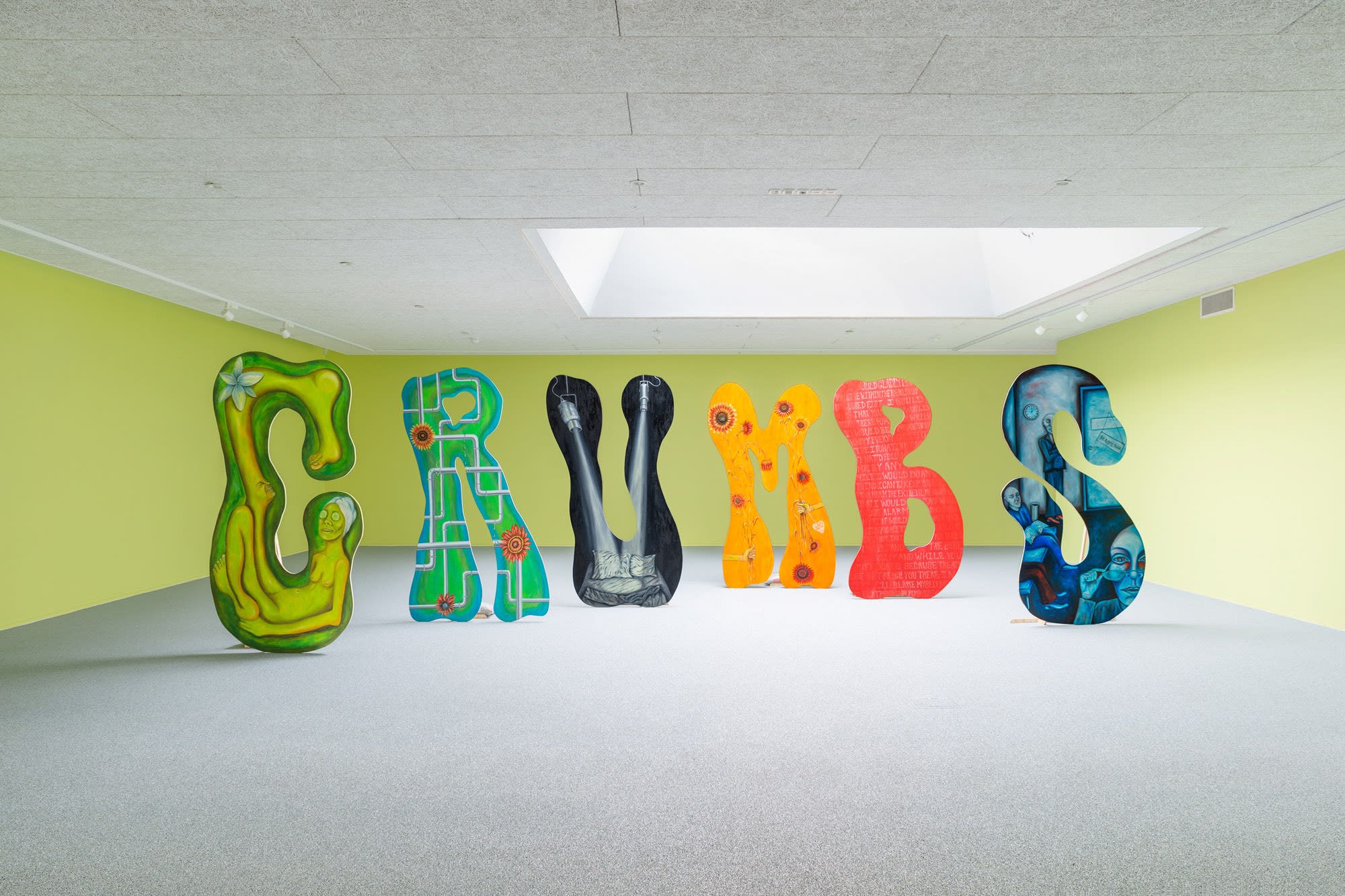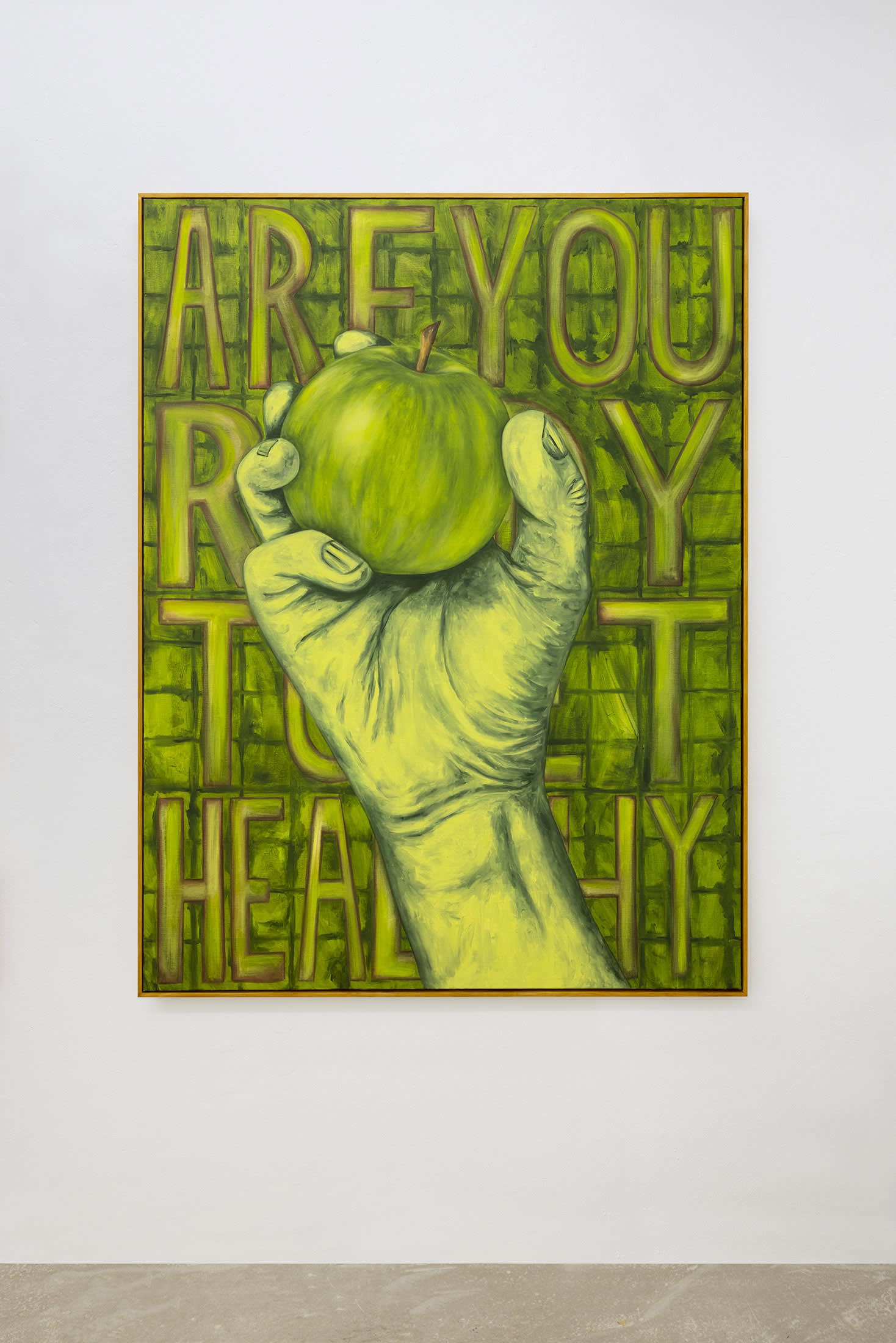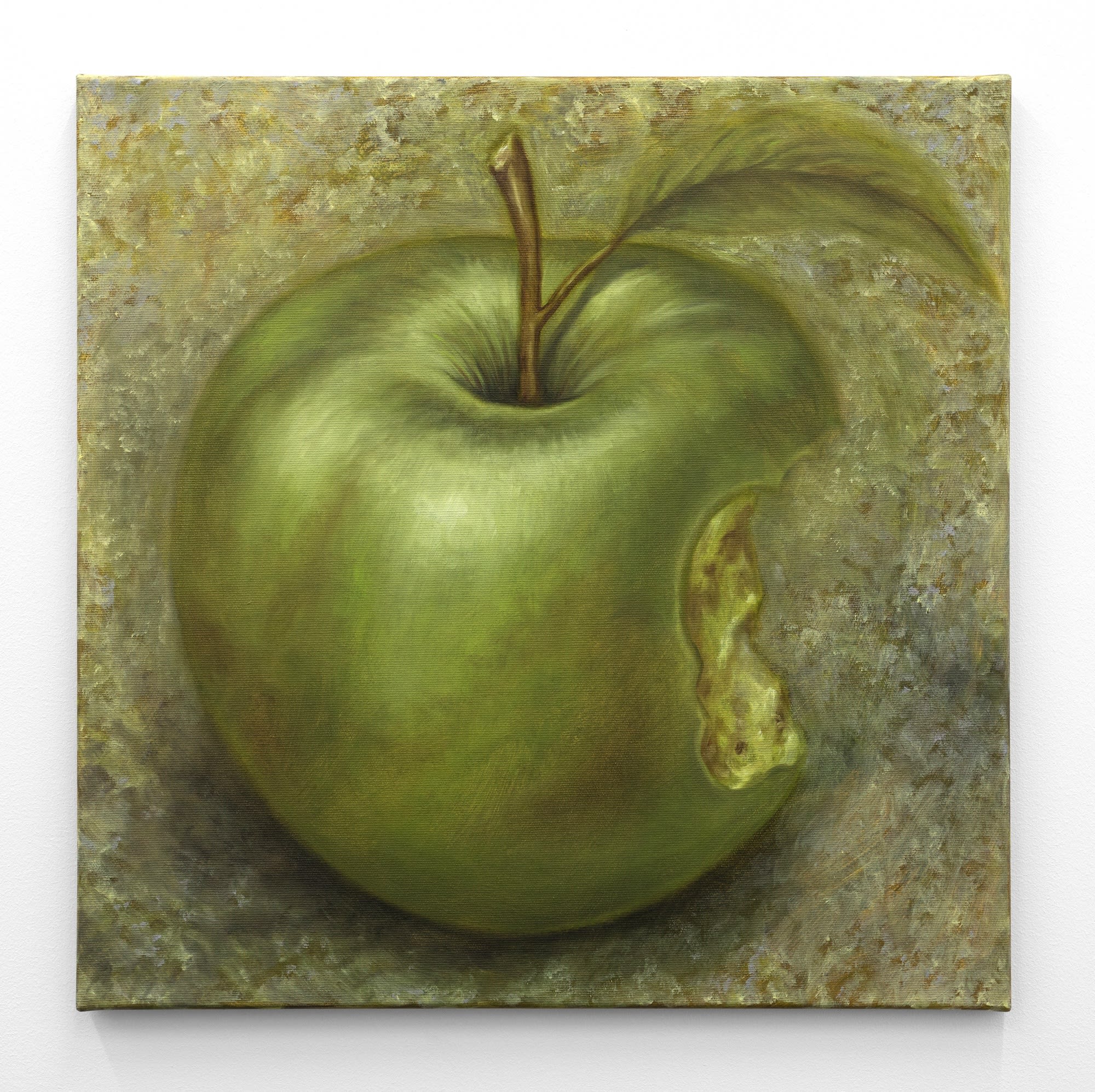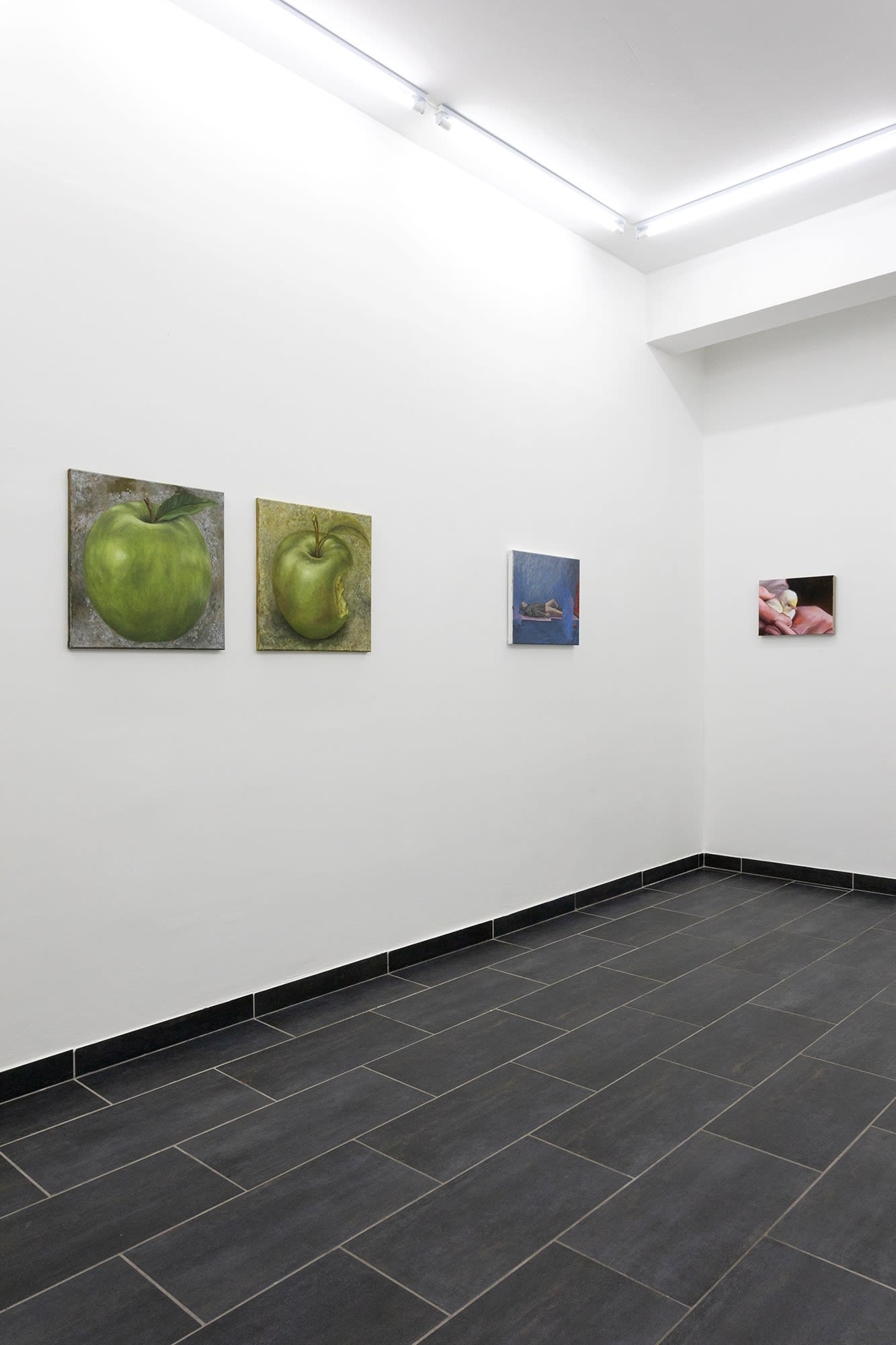 Portrait of Tanja Nis-Hansen. Courtesy of the artist and OTP Copenhagen.
Portrait of Tanja Nis-Hansen. Courtesy of the artist and OTP Copenhagen.
OTP: Ideas relating to illness, wellness and the body’s ability to perform labour seem to have played an important role in previous bodies of work. How relevant are these ideas to the works you are producing now?
TNH: These topics keep on being relevant to me. I guess that all my projects could be read as different attempts to describe a very peculiar and dizzying feeling of encountering one’s own mortality and fragility in a system that often works for profit and against our wellbeing. I am mostly interested in describing the psychological reactions which these structural glitches cause, like the frustrating feeling of sitting in a waiting room one too many times.
At the moment I am trying to boil things down to their essence and to, in a way, create a new alphabet to use for my own visual language. I am looking more into poetics within the written language and focusing on certain symbols that are relevant in relation to the body and its maintenance. Currently my research has led me to images of leaking pipes and apples. By narrowing down the image pool it has also opened up space to look even more closely into the technical aspects of painting and to rethink ways of using the medium. The material research and the continuous examination of the history of the medium are equally important to me.
 Tanja Nis-Hansen, An Apple a Day (5/365), 2024, oil on canvas, 50 x 50 cm / 19.5 x 19.5 inches [left], An Apple a Day (6/365), 2024, oil on canvas, 50 x 50 cm / 19.5 x 19.5 inches [right]. courtesy of the artist and OTP Copenhagen.
Tanja Nis-Hansen, An Apple a Day (5/365), 2024, oil on canvas, 50 x 50 cm / 19.5 x 19.5 inches [left], An Apple a Day (6/365), 2024, oil on canvas, 50 x 50 cm / 19.5 x 19.5 inches [right]. courtesy of the artist and OTP Copenhagen.
OTP: Julia Stephen’s book ‘Notes from Sick Rooms’ seems to have been an important text for you in the past. How did you come across this book and in what ways have its ideas informed your artistic practice?
TNH: Most of my projects take their starting point in literature in one way or another. A few years ago I read Anne Boyer’s ‘The Undying’. This book in itself is such a great testament to language in relation to illness, describing how language can both articulate and fail to capture the complexities of the sick body and the systems that surround it. It’s the kind of book that leaves you with a whole list of other writers that you want to delve into because the author reveals her own research so generously.
One of the books mentioned is Virginia Woolf’s ‘On Being Ill’. When I bought it, I was pleasantly surprised that her mother Julia Stephen’s 1883 book ‘Notes from Sick Rooms’ was included inside. It is a manual for caregivers and each chapter is divided into different aspects of caregiving at home. I was especially drawn to a chapter called “Crumbs”, which describes the evils of crumbs in bed for the bed-bound. I liked this action of highlighting something seemingly small and unnoticeable which, when not tended to, can cause a great deal of pain and discomfort to the sick person. This led me to create a work for Vestjyllands Kunstpavillon in 2022 called ‘Employee of the Month’. The work consisted of 6 big wood cutouts forming the word CRUMBS I treated each of the wooden letters as a painting and left remnants of the process such as sketches and notes stuck on the backside of them and presented it standing in the middle of the room, kind of like a big Hollywood sign, but for crumbs.
It was the particular simplicity and precision of how she used language to categorise her knowledge on caregiving, as well as the poetic potential within her writing which I took with me from the book. And that, in general, is something I am very interested in: how language and art can tenderly hold the weight of illness (or any other subject for that matter) while also attending to the smallest details.
 Tanja Nis-Hansen, Employee of the Month, 2022, installation view, Vestjyllands Kunstpavilon, Videbæk.
Tanja Nis-Hansen, Employee of the Month, 2022, installation view, Vestjyllands Kunstpavilon, Videbæk.
OTP: The paintings in this exhibition are taken from a new series of paintings called ‘An Apple a Day’. Could you talk about where the ideas for this series spawned from?
TNH: In 2023, I made a painting which depicts a hand holding an apple upon a background of text saying “ARE YOU READY TO GET HEALTHY?”. With this work in mind I started to think more about how to express a personal and societal frustration existing within a system that puts pressure on the individual to feel fully responsible for their own health and healing. I continued to look into the apple as a symbol which started to establish so many connections between different interests of mine, be it in relation to art history, painting, aesthetic hierarchies and of course most obviously in relation to health.
With the series 'An Apple a Day' I decided to give myself a frame to work within, which is to paint 365 apples. When I started this, the conceptual act of painting an apple a day in itself felt weirdly relevant and necessary, both personally as a meditation, but also in relation to my practice as a means of zooming in. As the series slowly grows I keep on seeing new potential within this action of repetition, and the process brings a lot of joy into the studio.
The title obviously refers to the saying “An apple a day keeps the doctor away” or as it was said back in the 1860’s: “Eat an apple on going to bed, and you will keep the doctor from earning his bread”, which even then had a lovely capitalist ring to it. Apart from showcasing an obvious frustration with our society’s neo-liberal demands on what it takes to be a healthy human being, the making of this series and its still life potential is also offering me a possibility to really go into a technical investigation and look at aesthetic hierarchies of taste and skill, something I’ve always been very provoked by and drawn to, with questions like “what is a good painting?” or “what makes a skilled painter?”, or “does this painting belong in a café or a museum?”
 Tanja Nis-Hansen, AREYOUREADYTOGETHEALTHY, 2023, oil on canvas, 165.5 x 122.5 cm / 65.2 x 48.2 inches [framed in pine]. courtesy of the artist and palace enterprise.
Tanja Nis-Hansen, AREYOUREADYTOGETHEALTHY, 2023, oil on canvas, 165.5 x 122.5 cm / 65.2 x 48.2 inches [framed in pine]. courtesy of the artist and palace enterprise.
OTP: How challenging have you found it to produce variations on the form of an apple? Do you feel pressured to produce a new variation each time, or does the repetition feel more like a time-based exercise to you?
TNH: I don’t think it’s necessary to force any variations. A friend who visited my studio one day said: “Why are you only painting Granny Smiths? don’t discriminate like that.” So now I can’t stop thinking about only painting Granny Smiths, but with 365 attempts I’m sure the series will automatically and organically adjust itself along the way.
I feel that as artists we are often expected to reinvent ourselves or constantly provide some kind of shock value, but at the moment my nervous system is finding great relief in being given a task which is first and foremost not physically exhausting, yet enduring and which opens my mind up to an ongoing research into the symbolism and poetics of the apple in relation to the human body and art history. The act of painting apples feels like a steady, slow and meaningful whisper. In a way, it feels more right for me to not shout so loudly these days.
 Tanja Nis-Hansen, An Apple a Day (4/365), 2024, oil on canvas, 50 x 50 cm / 19.5 x 19.5 inches. courtesy of the artist and OTP Copenhagen.
Tanja Nis-Hansen, An Apple a Day (4/365), 2024, oil on canvas, 50 x 50 cm / 19.5 x 19.5 inches. courtesy of the artist and OTP Copenhagen.
OTP: To what extend do you think the apple function as a stand-in for the human body, destined to consume it? Are there other apple-symbolisms that you have been interested to explore with this series?
TNH: Oh, there are so many, I don’t even know where to begin. So many wonderful artists have worked with the apple. Besides from delving deep into the aspects of the apple that relate to health and the human body, I am in a Cezanne-like phase at the moment, where it is the mere still-life observation of shape and light that occupies me, as well as the mundanity and beauty of the apple. The apple as a symbol is so incredibly rich.
Examining it through a feminist lens can reveal its associations with patriarchy, female autonomy, and the cultural narratives imposed on women. The biblical story of Eve eating the forbidden apple has long been used to justify the subjugation of women and to accuse them of moral corruption, but there is also a rewriting of the story that lets Eve have her apple and eat it too, and instead lets the act of taking the apple, symbolise a woman’s pursuit of knowledge, defying patriarchal norms that have historically denied women access to education and intellectual freedom.
In the category of the most obvious apple-symbolisms of our times, we also find the Apple logo, which features a bitten apple, and is one of the most recognisable symbols in modern culture. It offers a way of looking closer at consumerism and desire as well as branding and the commodification of information. For the last 6 years I have been working in IT, on the side, and I can feel that I will eventually have to succumb to the future and immerse myself in technology within my artistic research, whether this is going to happen through the apples or somewhere else, lets see.
Speaking of the future, I have to mention Charli XCX of course, the apple has been very present in pop culture in the last year. You will not see me doing TikTok videos but I can appreciate a good song when I hear one and I do think the apple's rotten right to the core.
 Tanja Nis-Hansen, An Apple a Day (6/365), 2024, oil on canvas, 50 x 50 cm / 19.5 x 19.5 inches. courtesy of the artist and OTP Copenhagen.
Tanja Nis-Hansen, An Apple a Day (6/365), 2024, oil on canvas, 50 x 50 cm / 19.5 x 19.5 inches. courtesy of the artist and OTP Copenhagen.
OTP: What is your relationship with portraiture? Do you find that you use other motifs as forms of indirect portraiture?
TNH: I am definitely someone who suffers a bit from pareidolia, recognising faces everywhere I look and wanting to put eyes on everything. Much of my work has revolved around the human figure and it is still my main interest to try and describe certain complex psychological aspects of the human mind. Portraiture is definitely a good way of doing this, but in my most recent projects I have specifically tried to look into what it means to depict a human condition without depicting the human body, by focusing on objects and text, which definitely ends up being a form of indirect portraiture.
OTP: You studied in Hamburg under professor Jutta Koether. Can you trace how your experience studying with them impact the way you are working today?
TNH: It has had a huge impact to be in the class of Jutta. Her teaching method was very open and generous and gave the students a lot of possibility to act and initiate collaboration and thinking together. We learned a certain way of looking at art and painting which I really appreciate today because it goes beyond a more classical skill-centric evaluation and leaves room for experimentation and for looking more closely at the actions, spaces, sounds and thoughts that painting can activate, while also having a closer look at which shoulders we as young artists stand upon.
 Tanja Nis-Hansen, An Apple a Day (5/365), 2024, oil on canvas, 50 x 50 cm / 19.5 x 19.5 inches. courtesy of the artist and OTP Copenhagen.
Tanja Nis-Hansen, An Apple a Day (5/365), 2024, oil on canvas, 50 x 50 cm / 19.5 x 19.5 inches. courtesy of the artist and OTP Copenhagen.
OTP: Could I ask you to talk a little bit about the spatial environments of your paintings? In the apple paintings we see in this show, the environments vary from grid-like repeating structures, to more ambient and dynamic atmosphere. Could I ask you to talk about the spaces you imagine your motifs being situated within?
TNH: It is not always the same, but I do have a tendency to place objects or figures into some sort of non-spaces in my paintings or perhaps we can call them slightly mannerist decorative non-spaces. Or we can go back to the psychological spaces of existential frustration and giddiness, or spaces that focus purely on the painterly gesture. More poetically, a void, or that annoying stuffy sound which you can still hear when using noise-cancelling headphones, or perhaps they are spaces of ephemeral dusty stage light. In my earlier work I was a bit more generous with placing figures or objects in a more familiar surrounding like a sort of room whether that be a bedroom, waiting room, or a spiral staircase, but it usually remained rather stiff and backdrop-like. Nowadays it is rare that I give anyone a proper chair to sit on, or any perspective.
OTP: You have presented performances and more immersive installations in the past. How have ideas of set design influenced your painting practice?
TNH: Theatricality and stage design have influenced my practice a great deal. It’s down to the flatness and mimicry that a stage uses to lure the viewer in, like the bare necessities of what it takes to trick the eye. I have always been interested in the rigidity of movement that comes from never being able to go beyond a certain border. The edge of the stage and the edge of the canvas have a lot in common in this way, it’s a full frontal view with an inbuilt awareness of a backstage. The performative characters that I have developed and played until now have also all had a certain degree of being stuck or limited in their movements, all relating to the limits of the body and mind. The stage becomes the meeting point for all my major interests: painting, performance, writing and sound. And as mentioned earlier, there is definitely an influence in my paintings of the theatrical, stagey non-space that I kind of seek to depict or end up depicting often with a focus on the isolation of objects, bodies, texts and symbols.
 Tanja Nis-Hansen, An Apple a Day (7/365), 2024, oil on canvas, 30 x 30 cm / 12 x 12 inches. courtesy of the artist and OTP Copenhagen.
Tanja Nis-Hansen, An Apple a Day (7/365), 2024, oil on canvas, 30 x 30 cm / 12 x 12 inches. courtesy of the artist and OTP Copenhagen.
OTP: You have incorporated text into paintings and more installation-based works in the past. Could I ask you to talk a little bit about your interest in reconciling text and image, or bringing them into close relation with one another, inside your practice?
TNH: When I started bringing my texts into the pictorial space it was primarily out of a necessity of merging together my writings with the rest of my artistic practice. I started by integrating text into my performances, then it moved onto the canvases and then onto the walls of the exhibition spaces in the form of woodcuts and murals. It all comes from an interest in semiotics and how we use language and symbols to create meaning or try to figure out how to talk about something. It feels like making art becomes a constant attempt to create a new language that can express a deep feeling, frustration or curiosity within ourselves which we have not been able to express in any other way. It also becomes interesting in terms of exploring hierarchies of taste, like what does it mean to write “love” on a canvas? I always stand in front of the canvas before writing on it, thinking; why are we so afraid of being banal?
 Interior Alphabet, installation view, 2024, OTP Copenhagen. courtesy of the artist and OTP Copenhagen.
Interior Alphabet, installation view, 2024, OTP Copenhagen. courtesy of the artist and OTP Copenhagen.
Tanja Nis-Hansen (b. 1988, Faxe; DK) lives and works in Berlin, Germany. The artist graduated with an MFA from the Academy of Fine Arts, Hamburg under the supervision of professor Jutta Koether. Recent exhibitions include: Impatient Girl at palace enterprise (Copenhagen; DK), Employee of the month at Vestjyllands Kunstpavillon (Videbæk; DK), The Great Spaghettification at Sans titre (Paris; FR).
